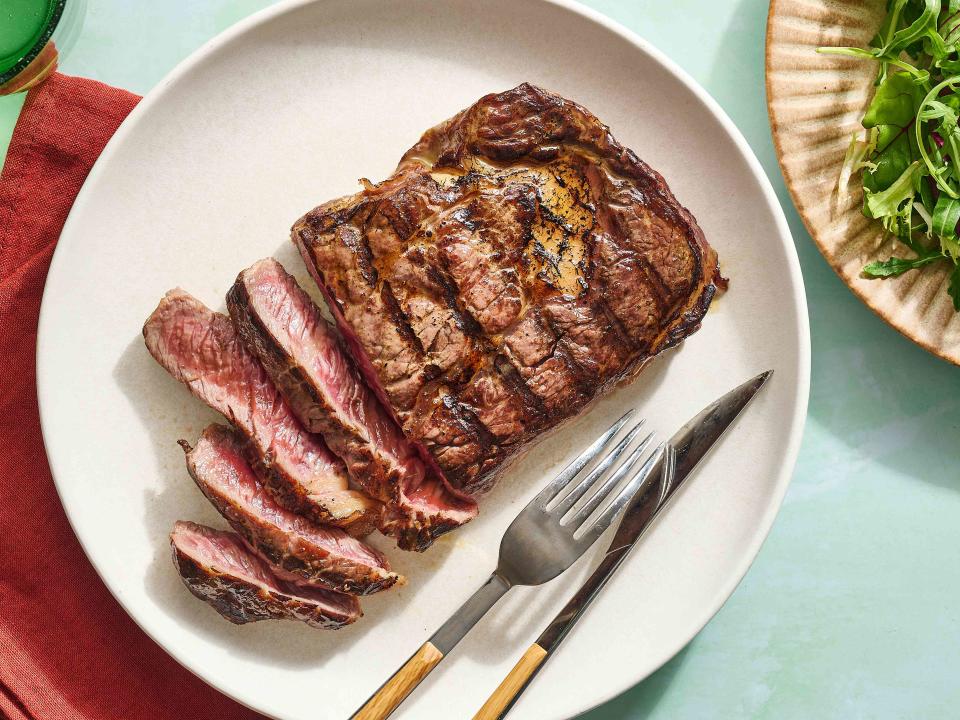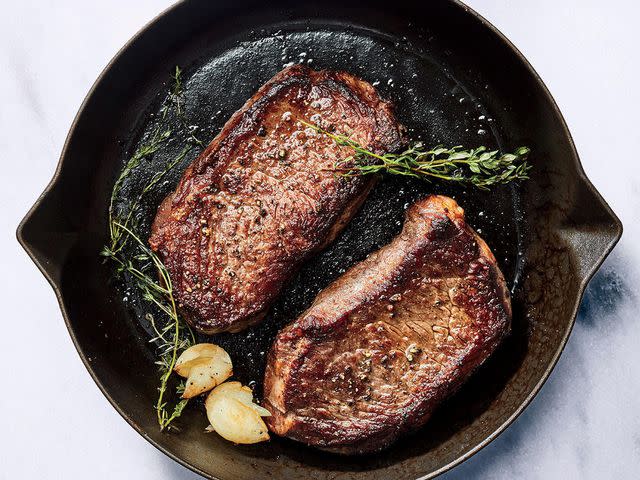How Not to Ruin an Expensive Steak, According to Omaha Steaks
It turns out you should save this step for last.

ALLRECIPES /JULIA HARTBECK
Imagine you just spent good money on some thick, well-marbled ribeye steaks. You place a thin, lightweight skillet on a burner, and crank up the heat. As the oil starts to smoke in the skillet, you grab a steak from the refrigerator and carefully place the cold meat in the pan. The steak sizzles away and once charred, you flip it and cook until you think it’s about medium-rare. Then you remove the steak from the heat and immediately thinly slice it only to find that the beautiful piece of meat is seriously overcooked as it sits in a pool of its own juices. It is fair to say that the steak didn’t turn out quite how you expected.
There are many issues in this scenario: cooking the steak in a lightweight skillet, not allowing the meat to rest, and forgetting to use an instant-read thermometer to get an accurate reading of the internal temperature. But there's one mistake that may surprise you.
For years we’ve been taught to cook steak over high heat to “seal in the juices” and create a nicely charred crust. As it turns out, there’s a better way to cook a steak. Rather than searing the meat first in a hot pan or on a grill, reverse searing ensures that thick, expensive steak stays juicy and perfectly cooked every time.
Reverse Searing is the Best Way to Cook Expensive Steaks

Considering four good quality ribeye steaks can cost $100 or more, it’s best to know what you are doing before you start cooking. Instead of just winging it, take some advice from David Rose, executive chef at Omaha Steaks, to make sure you don’t ruin that expensive steak.
“Reverse searing is a great way to guarantee a perfectly cooked steak every time, which is especially important if you're working with an expensive cut of meat,” Rose said.
So what exactly is reverse searing? It’s simply a method of cooking steak over moderately-low heat until it’s 10 to 15 degrees below your target final temperature, searing it to create a delicious crust, then resting it to redistribute the juices and finish carryover cooking.
Here’s how Rose recommends reverse searing steaks:
Choose the right steak. Rose recommends a steak at least 1 1/2 inches thick, such as a ribeye, filet mignon, or strip steak. “Thicker cut steaks are typically the more expensive option, and my personal preference as they cook more evenly and are packed with delicious juices and flavor.”
Remove the steaks from the refrigerator 20 to 30 minutes before cooking. “If you skip this step and cook your steaks right out of the fridge, you risk overcooking the steak on the outside before the inside is cooked,” Rose said. Be sure to pat the steaks dry with paper towels and liberally season with coarse cracked black pepper and kosher salt.
Place the steaks on a wire rack set over a baking sheet and bake at 250 degrees F. Remove the steaks from the oven when the internal temperature is 10 to 15 degrees below your desired doneness. If you want a rare (120 degrees F) steak, cook to 105 degrees F. For medium-rare (130 degrees F) cook to 115 degrees F, medium (140 degrees F) cook to 125 degrees F and medium-well (150 degrees F) cook to 135 degrees F. This can take anywhere from 20 minutes up to 40 minutes depending on the thickness of the steak and your desired final temperature.
Remove the steaks from the oven then set on the counter while you heat a cast-iron skillet over high heat. Pour in some oil then sear the steaks for one to two minutes per side, until they are well caramelized and browned and the internal temperature is 5 degrees below your desired doneness. “For extra flavor, add butter, ghee, duck fat, garlic cloves, or fresh herbs like thyme or rosemary to the skillet during the last minute of searing and baste in the skillet,” Rose said.
Finally, rest the steaks for at least five minutes on a plate to allow the juices to spread evenly throughout the meat. Resting also allows the steak to gently continue cooking to your desired internal temperature (known as carryover cooking). Do not skip this step or all that hard work will be for nothing.
The steak should be juicy and evenly cooked throughout as reverse searing retains much of the steak's natural moisture. Did you know you can reverse sear on the grill and even reverse sear a prime rib roast? And don’t forget to include some delicious sides for steaks and a sauce or compound butter for a perfect finish.
Read the original article on All Recipes.


